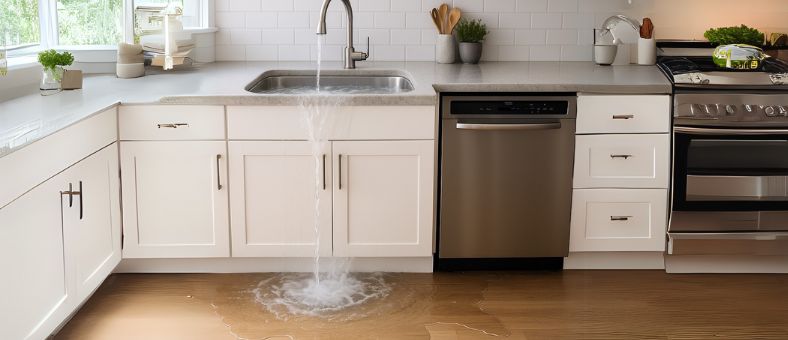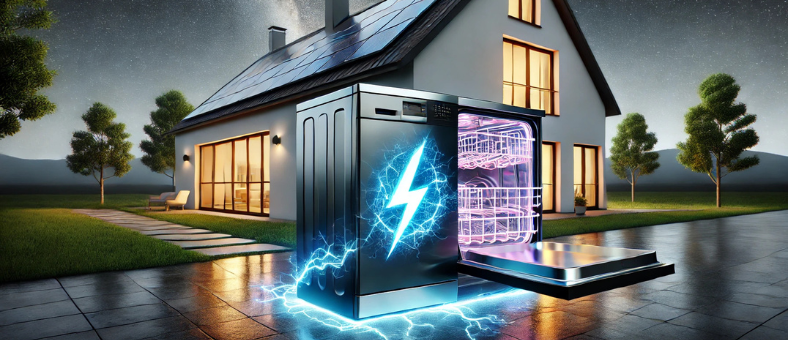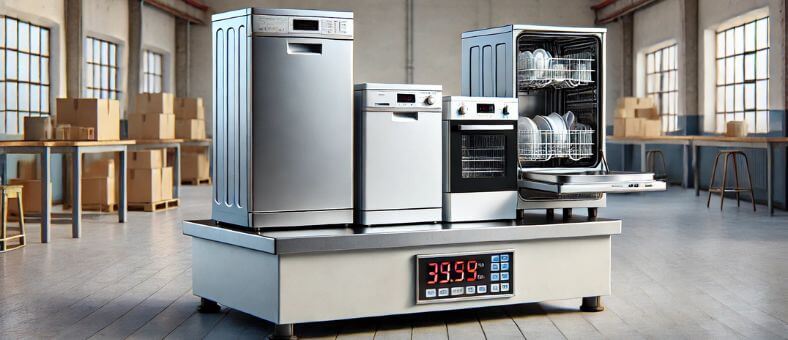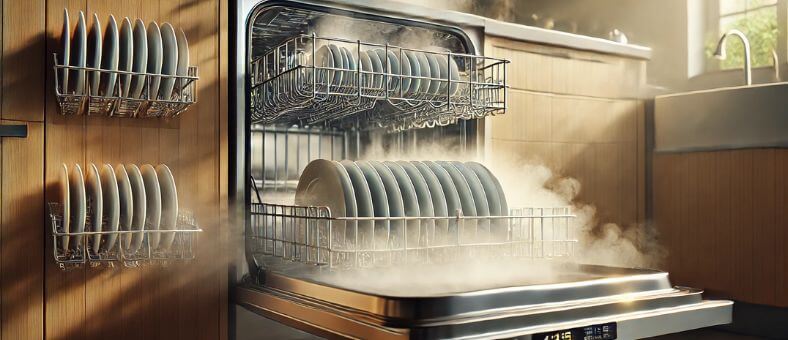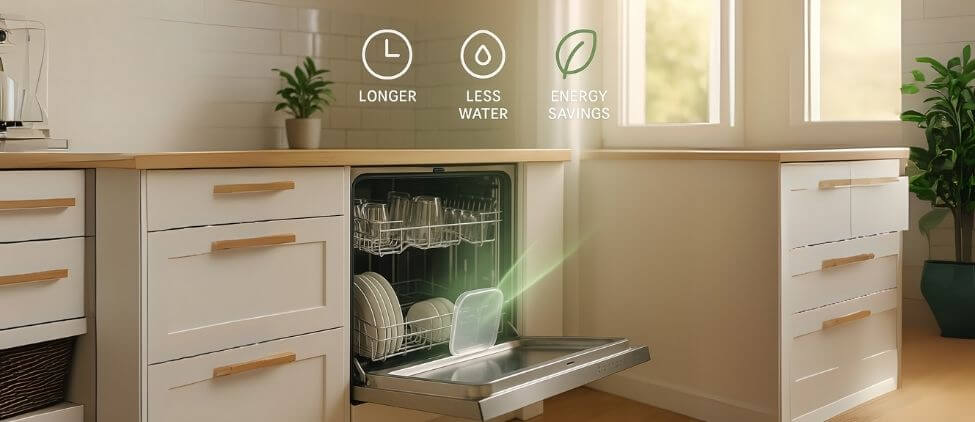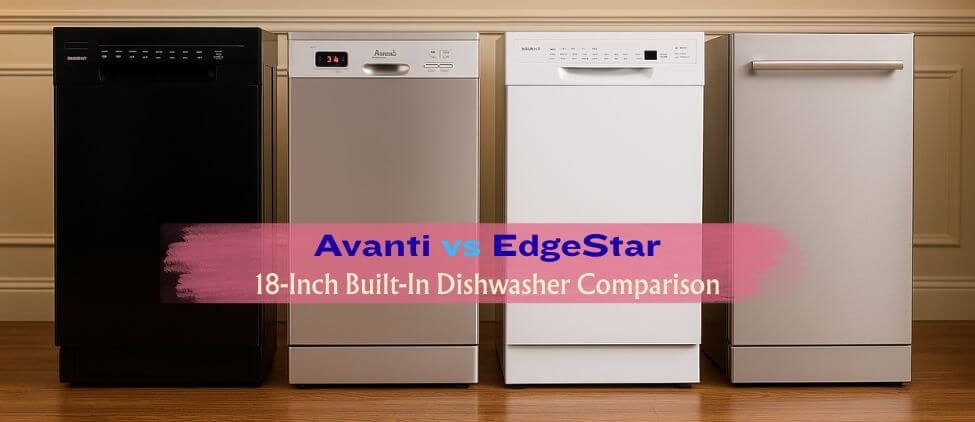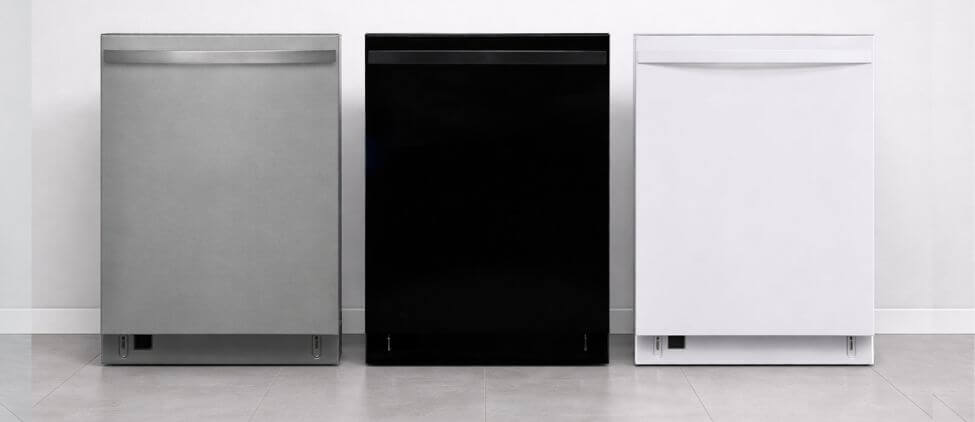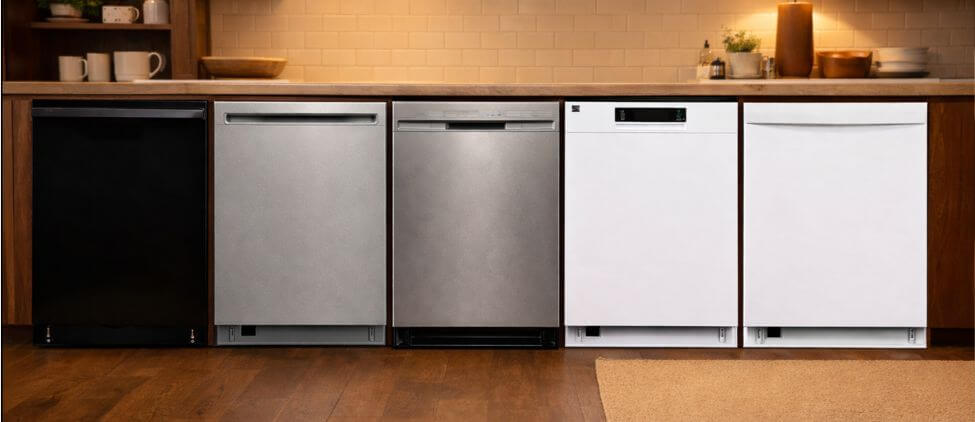Ever had your sink fill up while using the dishwasher? It’s confusing, isn’t it? “Why Does the Sink Fill Up When Running the Dishwasher?” is a question we’ve all asked. So, we’ve put together this easy-to-understand guide. It talks about the four main reasons why this happens. Once you know why, you can fix the problem much easier. So come along as we explore this curious dishwasher and sink problem. We’ve made this guide clear and straightforward to ensure that you can understand these issues better and get your dishwasher and sink working together nicely.
No more worrying about overflowing sinks when trying to clean your dishes! Remember, knowledge is power – the more you understand, the better you’ll handle any situation. Let’s jump right in and turn this annoying problem into a thing of the past!
Table of Contents
Reason 01: Clogged Sink
A clogged sink is one of the common causes of water backing up into the dishwasher. When the sink drain is obstructed by food debris, grease, or other substances, it restricts the water flow and prevents proper drainage. As a result, water from the dishwasher can flow back into the sink, causing it to fill up; it is essential to address the clog in the sink drain. You can use a plunger, a plumbing snake, or a mixture of baking soda and vinegar to break up the clog and restore proper drainage. Regular maintenance and avoiding the disposal of large food particles or grease down the drain can help prevent future clogs.
Reason 02: Obstructed Dishwasher
An obstructed dishwasher can also lead to water filling the sink during the dishwasher cycle. This occurs when there is a blockage or restriction in the dishwasher’s drain hose or pump. The backup can be caused by food particles, debris, or even small objects that accidentally entered the dishwasher. To address this issue, inspecting and clearing any obstructions in the dishwasher’s drain hose and pump is necessary. You can remove the dishwasher’s kick plate and access the drain hose and pump for inspection. If you find any blockages, carefully remove them using pliers or a small brush. Regularly cleaning the dishwasher’s filter and checking for debris can help prevent future obstructions.
Reason 03: Jammed Garbage Disposal
A jammed garbage disposal can also contribute to the sink filling up when running the dishwasher. Suppose the dishwasher and the sink share an identical drain line. In that case, a jammed garbage disposal can restrict proper drainage and cause water to back into the sink. To resolve this issue, you can attempt to manually free the jammed disposal using a wrench or the designated tool provided with the disposal unit. Ensure to turn off the power to the disposal before attempting any repairs. Suppose the jam persists or you need help safely resolving the issue. In that case, it is recommended to seek professional assistance from a plumber or appliance repair technician.
Reason 04: Blocked Air Gap
The air gap is a small device typically installed on the countertop or sink near the dishwasher. Its purpose is to prevent wastewater from the sink or garbage disposal from flowing back into the dishwasher. If the air gap becomes blocked or clogged, it can cause water to fill up the sink during dishwasher operation. To address this issue, you can inspect and clean the air gap by removing any debris or blockages. Use a small brush or toothpick to clear the openings and ensure proper airflow. Regularly maintaining the air gap and checking for blockages can help prevent future issues with sink drainage during dishwasher use.
Silent Damage Dealer
Continuous sink overflow due to the dishwasher can secretly cause water damage to your cabinets and floors, costing thousands in repairs.
How to Unclog Garbage Disposal Drain with DIY Methods
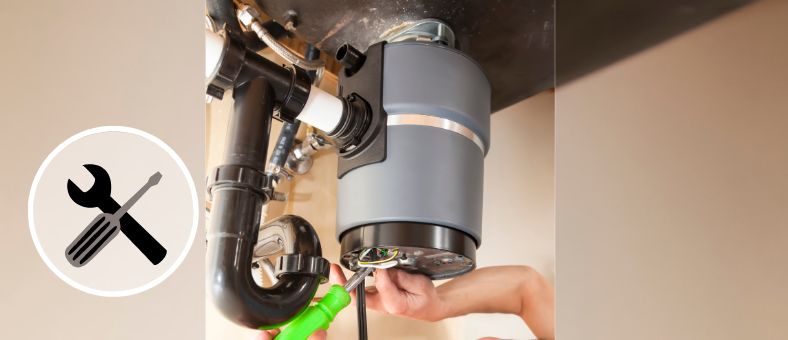
Unclogging a garbage disposal drain can be a common issue. Still, with the proper DIY methods and knowing when to seek professional help, you can restore proper functionality and save time and money. Explore practical techniques to unclog your garbage disposal drain and ensure a smooth operating system. Let’s get started!
Plunger Method
Place a plunger over the drain and create a tight seal. Push and pull the plunger forcefully to generate suction and dislodge the clog. Repeat several times if needed.
Baking Soda and Vinegar
Pour half a cup of baking soda into the drain, followed by one cup of vinegar. Let the mixture fizz for a few minutes to clear the blockage for optimal results. Flush with hot water to clear the drain.
Hot Water Method
Boil some water and carefully pour it down the drain slowly in two to three stages. The hot water can help dissolve grease and dislodge minor clogs.
Manual Removal
If you can visually locate the clog, use a pair of long-handled pliers or tongs to remove it. Be cautious and avoid putting your hand directly into the disposal.
Ice and Salt Method
Fill the disposal with a handful of ice cubes and a generous amount of coarse salt. Run the disposal while flushing it with cold water. The ice and salt help break down debris and clean the blades.
Reset the Disposal
A simple reset can sometimes resolve minor clogs. Press the reset button on the bottom or side of the disposal unit to reset the motor.
The Birth of Convenience
John W. Hammes invented the garbage disposal in 1927, transforming kitchen waste management and making clean-up a breeze!
Signs It’s Time to Call a Professional
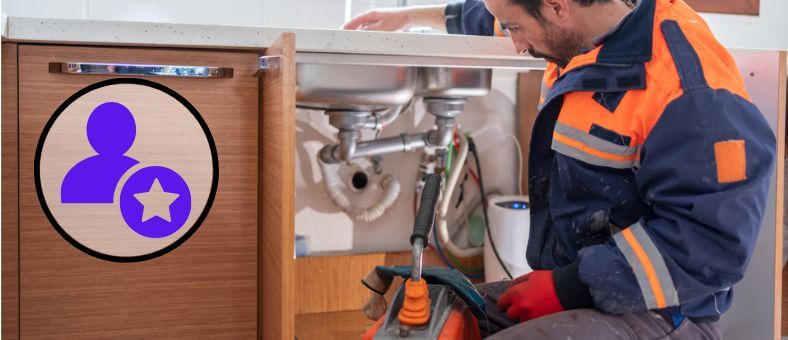
Persistent Clogs: If your DIY attempts are unsuccessful or the clogs keep recurring, it’s time to seek professional assistance.
Strange Noises or Odors
Unusual noises or foul odors from garbage disposal could indicate a more significant issue requiring expert attention.
Water Backup
If water backs up into the sink or drains slowly, it could be a sign of a more severe blockage in the plumbing system.
Preventive Maintenance
Professional plumbers can provide routine maintenance and inspections to keep your garbage disposal in optimal condition and prevent future clogs.
What to Do When Your Sink Drains into the Dishwasher
Check for Clogged Drain Lines
- Remove any visible debris or food particles from the sink and dishwasher drains.
- Use a plunger to try and clear any blockages in the drain lines.
- If the clog persists, use a drain snake or auger to remove the obstruction.
- Consider using a drain cleaning solution to break down stubborn clogs.
Verify Proper Installation
- Ensure the dishwasher drain hose is connected securely to the sink drain or garbage disposal.
- Check that the drain hose has a high loop or air gap to prevent the backflow of water from the sink into the dishwasher.
- Inspect the dishwasher’s air gap device, if present, and clean it if it’s clogged.
- Make sure the dishwasher’s drain hose is not kinked or blocked.
Address Plumbing Issues
- Check for any issues with the sink’s plumbing, such as a faulty or malfunctioning sink trap or drainpipe.
- Replace any worn-out or damaged plumbing components that may be causing the issue.
Run Water Before Starting the Dishwasher
- This also provides an opportunity to check for unusual occurrences, such as slow draining or peculiar sounds, which can indicate potential problems in your drainage system.
- By flushing the system in advance, you are priming your plumbing system for the influx of water released by the dishwasher, better preparing it to handle the load and potentially preventing backups.
- If your dishwasher is connected to the garbage disposal, running the water also ensures the disposal is clear of waste, reducing the chance of clogs.
- This simple habit is also an opportunity to clean your sink, further improving the overall hygiene of your kitchen.
Regular Maintenance
- Clean the dishwasher’s filter regularly to prevent debris from clogging the drain.
- Run a dishwasher’s vinegar or citric acid cleaning cycle to remove any built-up residue or mineral deposits.
Seek Professional Help
Suppose you have tried troubleshooting steps, and the issue persists. In that case, it may be time to consult a professional dishwasher repair technician or plumber.
They can accurately diagnose the problem and provide expert solutions to resolve the drainage issue effectively.
Maintaining Proper Drainage: Tips for a Smooth Dishwasher-Sink Connection
A well-functioning drainage system is essential for efficient dishwasher operation and a clean kitchen environment. Following these tips and guidelines ensures that water flows seamlessly from your dishwasher to the sink, preventing backups and clogs. From aligning your dishwasher and checking the drain hose to optimizing loading and consulting the dishwasher manual, we will explore various strategies to maintain proper drainage and enhance the performance of your dishwasher. Let’s get started.
Proper Alignment
Ensuring the proper alignment of your dishwasher and sink is essential for maintaining a smooth connection. Misalignment can lead to water backup and drainage issues. Take the time to adjust and align the dishwasher with the sink, following the manufacturer’s guidelines or consulting a professional if needed.
Check the Drain Hose
Inspecting the drain hose is crucial for proper drainage. Look for any kinks, clogs, or damage obstructing the water flow. Clear any blockages and straighten out curls to allow smooth drainage from the dishwasher to the sink.
High Loop or Air Gap
Consider installing a high loop or air gap in the dishwasher drain line. These mechanisms prevent wastewater from flowing back into the dishwasher, reducing the risk of the sink filling up during dishwasher operation. Consult a professional or refer to the dishwasher manual for installing a high loop or air gap.
Regular Cleaning and Maintenance
Regularly cleaning and maintaining the dishwasher and sink can help prevent drainage problems. Remove debris and food particles from the dishwasher filter, clean the sink drain, and use appropriate cleaning agents to avoid buildup and blockages.
Optimize Dishwasher Loading
Proper loading of the dishwasher can contribute to efficient drainage. Avoid overcrowding the dishwasher and ensure that dishes, utensils, and cookware are positioned correctly to allow water to flow freely. Consider rearranging items or running smaller loads if necessary.
Avoid Excessive Detergent Usage
Excessive detergent can lead to excessive suds and foam, impeding proper drainage. Follow the recommended detergent dosage provided by the dishwasher manufacturer and avoid overfilling the detergent dispenser.
Monitor Sink Drain Performance
Keep an eye on the performance of your sink drain. If you notice slow drainage or backups, it may indicate a problem in the drain line or plumbing system. Address any issues promptly to maintain a smooth dishwasher-sink connection.
Proper Sink Installation
Proper installation of the sink is crucial for maintaining adequate drainage. Ensure the sink is securely attached and sealed and the drain is aligned and functioning correctly. If you suspect any issues with the sink installation, consult a professional for assistance.
Consult Dishwasher Manual
Always refer to the dishwasher manual for specific instructions and guidelines regarding installation, maintenance, and troubleshooting. The manual provides valuable information tailored to your particular dishwasher model.
Professional Assistance
If you encounter persistent drainage issues or are unsure about any aspect of your dishwasher-sink connection, feel free to seek professional assistance. A qualified plumber or appliance technician can diagnose and address any underlying problems, ensuring proper drainage and optimal dishwasher performance.
How to fix overflowing sink problems at home
When faced with an overflowing sink, it’s possible to tackle the issue using several at-home solutions before calling a professional plumber. Here’s a step-by-step guide to mitigate the problem.
- Immediately turn off the faucet supplying water to your sink to prevent further flooding.
- Utilize a large pitcher or similar container to scoop out as much water from the sink as possible. Dispose of this water safely, either into another sink or toilet.
- Utilize a plunger to dislodge the clog causing the overflow.
- If the clog persists, position a bucket under your sink’s drain trap (the J-shaped pipe) to catch any water. Gradually loosen the fittings and carefully remove the trap, emptying residual water into the bucket.
- To remove the clog in the drain trap, you can use a wire hanger or a plumber’s snake. Running hot water through the trap can also assist in loosening any stubborn blockages.
- Once cleared, reinstall the drain trap and let tap water run through your sink for several minutes to confirm the issue is resolved.
For a comprehensive guide on fixing a clogged sink, you might find this video useful: How to Fix a Clogged Sink | Plumbing Repairs
Overflowing Equals Water Wastage
An overflowing sink can waste up to 2 gallons of water per minute. Fixing it saves both your home and the environment!
Sink Plumbing with Dishwasher
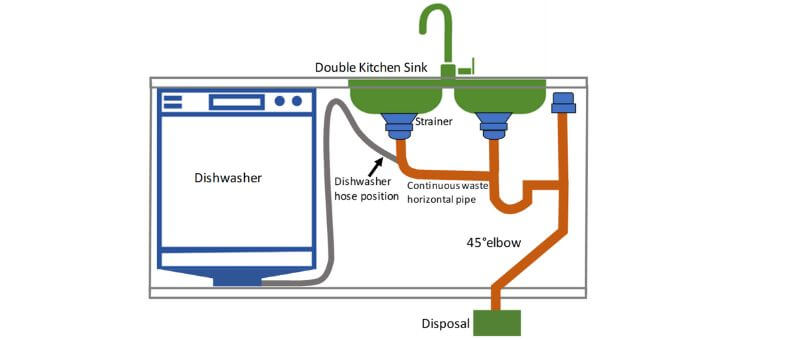
Wrapping Up: Why Does the Sink Fill Up When Running the Dishwasher?
Keeping your dishwasher and sink working together smoothly is super important. It helps your dishwasher do its job and keeps your kitchen clean and fresh. The helpful tips in this article make it easy to keep things flowing right.
Just remember to line things up, keep an eye on the drain hose, and consider using a high loop or air gap. Don’t forget to keep your machine clean and not over-stuff it. Also, use just the right amount of soap!
Always keep an eye on how your sink is draining, and make sure it’s installed right. For clarification, peek at your dishwasher’s manual or ask a pro for help. Following these simple steps, you’ll have a dishwasher that works excellently, drains appropriately, and makes doing dishes a breeze!
At WashDryDazzle, we’re dedicated to providing essential insights that make your daily chores effortless. Dive deeper into our comprehensive Dishwasher Education hub to learn more.
Frequently Asked Questions (FAQs)
What is a drainage system?
A drainage system is a network of pipes and channels that carry water away from an area to prevent flooding and water damage.
Why is a properly functioning drainage system important?
A properly functioning drainage system helps prevent water damage to your home, reduces soil erosion, and prevents the buildup of stagnant water, which can attract pests.
What is the purpose of a dishwasher drain hose?
A dishwasher drain hose carries wastewater from the dishwasher to the drainage system or garbage disposal under your sink.
How often should I check my dishwasher drain hose?
It’s good practice to check your dishwasher drain hose every six months for any signs of damage, blockages, or leaks.
How can I prevent my kitchen sink from overflowing?
Regular cleaning of your sink and drain can help prevent clogs. You can also invest in a sink strainer to catch larger food particles and avoid pouring grease or oil down your sink.
What do I do if my sink is already overflowing?
Shut off the water source and use a plunger to dislodge the blockage. If this doesn’t work, consider using a plumber’s snake or calling a professional.
How often should I clean my drain pipes?
It’s recommended to clean your drain pipes every few months to prevent blockages and maintain optimal drainage.
Can I clean my drain pipes myself?
Yes, there are several DIY methods for cleaning drain pipes, including using a plunger, a plumber’s snake, or a homemade drain cleaner solution.
What causes water to back up in my home?
Water can back up due to a clog in your plumbing system, a blocked vent pipe, or issues with your city’s main sewer line.
How can I prevent water from backing up in my home?
Regular plumbing system maintenance, including professional inspections, can help prevent water backups. Also, consider installing a backwater valve to prevent sewage from flowing back into your home.
Solve Dishwasher Issues with Ease
Encounter a problem with your dishwasher? Fear not! We provide clear, straightforward solutions for a range of common dishwasher issues. From quick fixes to more complex troubleshooting, these guides will transform you into a confident kitchen technician, ready to tackle any challenge your dishwasher might present:
- How to Fix Your Dishwasher: Troubleshooting and Repair
- 8 Easy Steps to Fix a Non-Draining Dishwasher
- Fix Your Countertop Dishwasher Not Draining in Just 6 Easy Steps!
- Dishwasher Pod Not Dissolving? Discover 8 Shocking Reasons Why!
- Dishwasher Door Unlocking During A Cycle? Tips To Help
- 5 Reasons Your Dishwasher Control Panel Is Not Working!
- Dishwasher Not Heating Water? Uncover 6 Surprising Reasons!
- Dishwasher Making Buzzing Noise? Top 6 Fixes to Restore Peace!
Maximizing Your Dishwasher’s Economic and Eco-Efficiency
Learn about the economics of dishwasher use and how to improve energy and water consumption. Get practical tips to enhance your dishwasher’s efficiency and save on utility bills while reducing environmental impact. Dive into our helpful resources:
- How Much Electricity Does it Cost to Run a Dishwasher?
- How Much Water Do Dishwashers Use?
- Dishwasher vs Hand Washing– The Better Choice

